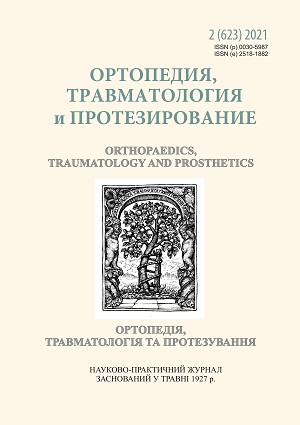Combined soft tissue plastics in treatment of the leg infected necrotic lesions
DOI:
https://doi.org/10.15674/0030-59872021251-57Keywords:
Leg, fractures, complications, infected necrotic tissue defects, angiosomes, plastic surgeryAbstract
Anatomical features of the leg create prerequisites for the occurrence of severe damage to bone-soft structures with the further development of infection-necrotic complications and osteoielitus. A difficult problem is the development of infected soft tissue defects. Objective. To study the effectiveness of the use of plastic surgical technologies using skin-fascial and muscular patches based on angiosomal concept by Taylor & Palmer. Methods. Treatment results analysis of 3 patients with necrotic defects of the leg soft tissues. All patients initially received high-energy different sites fractures of the leg bones and they were given metaloostheosynthesis using plates. In all cases, treatment was complicated by the occurrence of trophic disorders with infected full-layer defects of soft tissues that did not heal. Results. According to the angiosomal Taylor’s & Palmer’s theory, the human body is divided into 40 three-dimensional zones that combine skin with subordinate fiber and muscles, and have clear limits of blood supply to one nourishing artery. Full-haired soft-blooded patches, taking into account areas of angiosomes, are supplied throughout the plane and to the full depth, which guarantees much better results at the transplant site. The use of traditional plastics technologies in study group patients, on previous treatment did not lead to positive results, and the use of combined plastics based on the angiosomes concept allowed to obtain 100 % positive results, with complete healing of the foci of infection and the absence of relapses. Conclusions. A new stage in the development of plastic surgery, based on the angiosomes theory of human body structure by the blood supply to Taylor & Palmer, is promising for use in traumatology orthopaedics. The experience of using angiosomal patches for plastics of infected defects of the leg soft tissues has proved the high efficiency of this technology, which confirms the expediency of continuing research into the angiosomal theory in the treatment of such pathology another sites. Retrospective analysis of the etiology and pathogenesis for the leg tissues post-traumatic infected defects can be used to correct fracture treatment tactics in order to avoid the development of such complications.
References
- Shibaev, E. Yu., Ivanov, P. A., & Nevedrov, A. V. (2018). Tactics of treatment of post-traumatic defects of soft tissues of the extremities. Zh. N.V. Sklifosovsky Research Institute for Emergency Medicine, 7(1), 37–43. https://doi.org/10.23934/2223-9022-2018-7-1-37-43. [in Russian]
- Hamnerius, N., Wallin, E., Svensson, Å., Stenström, P., & Svensjö, T. (2016). Fast and Standardized Skin Grafting of Leg Wounds With a New Technique: Report of 2 Cases and Review of Previous Methods. Eplasty, 16, e14.
- Belousov, A. E. (1998). Plastic reconstructive and aesthetic surgery. St. Petersburg : HIPPOCRATES. [in Russian]
- AlMugaren, F. M., Pak, C. J., Suh, H. P., & Hong, J. P. (2020). Best local flaps for lower extremity reconstruction. Plastic and Reconstructive Surgery - Global Open, 8(4), e2774. https://doi.org/10.1097/gox.0000000000002774
- Zenn, M. R., & Jones, G. (2012). Reconstructive surgery. Anatomy, Technique, and Clinical Applications. Thieme
- Saint-Cyr, M., Wong, C., Schaverien, M., Mojallal, A., & Rohrich, R. J. (2009). The Perforasome theory: Vascular anatomy and clinical implications. Plastic and Reconstructive Surgery, 124(5), 1529-1544. https://doi.org/10.1097/prs.0b013e3181b98a6c
- Taylor, G., & Palmer, J. (1987). The vascular territories (angiosomes) of the body: Experimental study and clinical applications. British Journal of Plastic Surgery, 40(2), 113–141. https://doi.org/10.1016/0007-1226(87)90185-8
- Taylor, G. I., Corlett, R. J., Dhar, S. C., & Ashton, M. W. (2011). The anatomical (Angiosome) and clinical territories of cutaneous perforating arteries: Development of the concept and designing safe flaps. Plastic and Reconstructive Surgery, 127(4), 1447–1459. https://doi.org/10.1097/prs.0b013e318208d21b
- Toshiharu, M., Katsumata, S., Ogo, K., & Taylor, G. I. (2004). 040 The function of ‘Choke vessels’ to the blood flow: Angiographic and laser flow-graphic study on the rat flap model. Wound Repair and Regeneration, 12(1), A15-A15. https://doi.org/10.1111/j.1067-1927.2004.abstractbc.x
- Taylor, G. I., Corlett, R. J., & Ashton, M. W. (2017). The functional Angiosome. Plastic and Reconstructive Surgery, 140(4), 721-733. https://doi.org/10.1097/prs.0000000000003694
- Samoilenko, G. E., Zharikov, S. O., & Klimansky, R. P. (2019). Application of "propeller" technique for plastics of extensive wounds of the distal lower extremity. Clinical Surgery, 86(3), 27–31. https://doi.org/10.26779/2522-1396.2019.03.27. [in Ukrainian]
Downloads
How to Cite
Issue
Section
License

This work is licensed under a Creative Commons Attribution 4.0 International License.
The authors retain the right of authorship of their manuscript and pass the journal the right of the first publication of this article, which automatically become available from the date of publication under the terms of Creative Commons Attribution License, which allows others to freely distribute the published manuscript with mandatory linking to authors of the original research and the first publication of this one in this journal.
Authors have the right to enter into a separate supplemental agreement on the additional non-exclusive distribution of manuscript in the form in which it was published by the journal (i.e. to put work in electronic storage of an institution or publish as a part of the book) while maintaining the reference to the first publication of the manuscript in this journal.
The editorial policy of the journal allows authors and encourages manuscript accommodation online (i.e. in storage of an institution or on the personal websites) as before submission of the manuscript to the editorial office, and during its editorial processing because it contributes to productive scientific discussion and positively affects the efficiency and dynamics of the published manuscript citation (see The Effect of Open Access).














